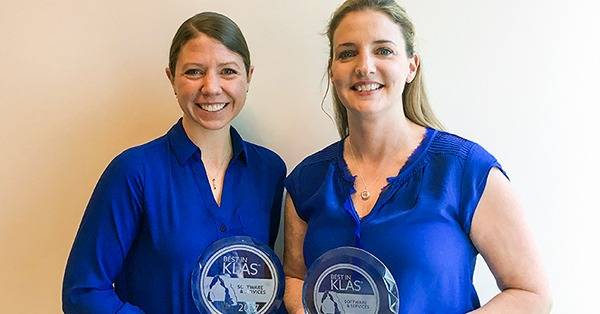- Solutions
- Solutions
- Home Health
- Hospice
- Life Plan Community
- Palliative Care
- Private Duty
- Senior Living
- Skilled Nursing
- Skilled Nursing
- Skilled Nursing Software
- Advanced Insights
- Customer relationship management
- Data and analytics
- Financial & operations management
- Marketing
- Nutrition management
- Referral management
- Regulatory compliance
- Retail management
- Resident engagement
- Revenue cycle management
- Skilled nursing interoperability
- Partners
- Blogs
- Resources
- About
- User Conference

CPOE (Computerized Physician Order Entry): Just what the doctor ordered!
CPOE products have been around for decades. However, the industry has not kept up with the needs of physicians as evidenced by a study from the Mayo Clinic. These products need to optimize for the most precious resource that a physician has to offer: Focused time with a resident/patient! This focused time is THE key to a high quality-of-care outcome. In addition, bundled payments and value-based care have further raised the bar on requirements for physicians associated with the long-term, post-acute care (LTPAC) industry. The physician now needs to know details of the patient across the entire spectrum of care, not just the current episode.
The best way a CPOE product can give the precious resource of time back to physicians is to focus on: usability, mobility, and longitudinal data.
Usability:
Product design for usability needs to be a part of standard Agile scrum team software development practices. Starting with user research, developing a workflow and design, releasing increments of product in sprints (typically every 2 to 4 weeks), and iterating based on customer feedback. The usability team needs to embed itself with the scrum team to ensure that usability is front and center during development. The major advantage of following Agile Scrum practices for usability is that feedback and course correction is built into the process. Usability considerations go hand in hand with mobility and interface requirements (e.g. voice-based or gesture-recognition). More research and development is needed before these technologies become widely used by physicians. While it may take time, there is no question that user interfaces for physician order entry are going to be vastly different from the interfaces available today. Finally, most physician products focus on just medications. Physicians need structured interfaces that include lab, radiology, dietary and therapeutic orders.
Mobility:
It is critical that every application is designed using responsive/adaptive design techniques. These software design techniques allow browsers to perform similarly from a desktop and a handheld device like a smartphone. For physicians, it is doubly important that they have access to handheld devices at a point of care. Due to network connectivity limitations in the past, designers had no choice but to develop downloadable, app-based products. Today, network connectivity issues are significantly less prevalent, especially in environments in which physicians operate. Responsive software designs are a pragmatic way to create products for mobile and desktop environments simultaneously. Finally, products designed for mobility need to support 2-factor authentication for controlled-substances prescriptions and HIPAA compliance.
Longitudinal Data:
In the LTPAC industry, physicians need to know the entire history of the patient or resident to prescribe the right orders. The physician needs the entire longitudinal record of care associated with the patient from the entire spectrum of care (hospital, home health, and care, skilled nursing, etc.). With respect to medications, the physician needs to know and reconcile the meds taken by the patient to understand the history before prescribing. They also need to have real-time accurate data with DUR (Drug Utilization Reviews), contraindications, potentially relevant genetic information (Pharmacogenomics), and out-of-formulary alerts (cost optimization).
MatrixCare Connect is a powerful new interactive role-based care coordination platform for long-term care. It provides users (patients/residents, physicians, families) information from any electronic medical or health record—across provider boundaries—to access a comprehensive, global view of a resident’s health. It includes a physician-focused order-entry (CPOE) application that supports a mobile-friendly, highly-intuitive-usability interface that uses the Agile-Scrum software development process described here and leverages the patient’s longitudinal data in Connect. MatrixCare Connect provides the foundation for exactly the type of CPOE that a doctor would order!
Request a demo today for a closer look at MatrixCare.
See what MatrixCare can do for you
MatrixCare
MatrixCare provides an extensive range of software solutions and services purpose-built for out-of-hospital care settings. As the multiyear winner of the Best in KLAS award for Long-Term Care Software and Home Health and Hospice EMR, MatrixCare is trusted by thousands of facility-based and home-based care organizations to improve provider efficiencies and promote a better quality of life for the people they serve. As an industry leader in interoperability, MatrixCare helps providers connect and collaborate across the care continuum to optimize outcomes and successfully manage risk in out-of-hospital care delivery.
MatrixCare is a wholly-owned subsidiary of ResMed (NYSE: RMD, ASX: RMD). To learn more, visit matrixcare.com and follow @MatrixCare on X
Related Posts


See MatrixCare in action
Start by having a call with one of our experts to see our platform in action.
MatrixCare offers industry-leading software solutions. Thousands of facility-based and home-based care organizations trust us to help them improve efficiency and provide exceptional care.
© 2025 MatrixCare is a registered trademark of MatrixCare. All rights reserved.






